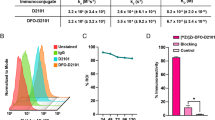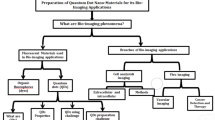Abstract
An ultrasensitive fluorescence biosensor for detecting cytokeratin fragment antigen 21-1 (CYFRA 21-1) DNA of non-small cell lung carcinoma (NSCLC) is designed using polysaccharide and activator regenerated by electron transfer atom transfer radical polymerization (ARGET ATRP) signal amplification strategy. Thiolated peptide nucleic acid (PNA) is fixed on magnetic nanoparticles (MNPs) by a cross-linking agent and hybridized with CYFRA 21-1 DNA. Hyaluronic acid (HA) is linked to PNA/tDNA heteroduplexes in the form of carboxy-Zr4+-phosphate. Subsequently, multiple 2-bromo-2-methylpropionic acid (BMP) molecules are linked with HA to initiate ARGET ATRP reaction. Finally, a large number of fluorescein o-acrylate (FA) monomers are polymerized on the macro-initiators, and the fluorescence signal is significantly amplified. Under optimal conditions, this biosensor shows a significant linear correlation between the fluorescence intensity and logarithm of CYFRA 21-1 DNA concentration (0.1 fM to 0.1 nM), and the limit of detection is as low as 78 aM. Furthermore, the sensor has a good ability to detect CYFRA 21-1 DNA in serum samples and to recognize mismatched bases. It suggests that the strategy has broad application in early diagnosis by virtue of its high sensitivity and selectivity.

A novel and highly sensitive fluorescence biosensor for quantitatively detecting CYFRA 21-1 DNA via dual signal amplification of hyaluronic acid and ARGET ATRP reaction was developed. This proposed method has a low detection limit, wide detection range, high selectivity, and strong anti-interference.







Similar content being viewed by others
References
Kanwal M, Ding X, Cao Y. Familial risk for lung cancer. Oncol Lett. 2017;13(2):535–42.
Zhao G, Li M. Ni-Doped MoS2 biosensor: a promising candidate for early diagnosis of lung cancer by exhaled breathe analysis. Appl Phys A Mater Sci Process. 2018;124(11):751.
Arya SK, Bhansali S. Lung cancer and its early detection using biomarker-based biosensors. Chem Rev. 2011;111(11):6783–809.
Bharti A, Ma PC, Salgia R. Biomarker discovery in lung cancer-promises and challenges of clinical proteomics. Mass Spectrom Rev. 2007;26(3):451–66.
Kammer MN, Kussrow AK, Webster RL, Chen HD, Hoeksema M, Christenson R, et al. Compensated interferometry measures of CYFRA 21-1 improve diagnosis of lung cancer. ACS Comb Sci. 2019;21(6):465–72.
Mizuquchi S, Nishiyama N, Iwata T, Nishida T, Izumi N, Tsukioka T, et al. Serum sialyl Lewis x and cytokeratin 19 fragment as predictive factors for recurrence in patients with stage I non-small cell lung cancer. Lung Cancer. 2007;5(4):374.
Dohmoto K, Hojo S, Fujita J, Ueda Y, Bandoh S, Yamaji Y, et al. Mechanisms of the release of CYFRA21-1 in human lung cancer cell lines. Lung Cancer. 2000;30(1):55–63.
Schmidt B, Beyer J, Dietrich D, Bork I, Liebenberg V, Fleischhacker M. Quantification of cell-free mSHOX2 plasma DNA for therapy monitoring in advanced stage non-small cell (NSCLC) and small-cell lung cancer (SCLC) patients. PLoS One. 2015;10(2):e0118195.
Li S, Li G, Du Z, Zhu L, Tian J, Luo Y, et al. The ultra-sensitive visual biosensor based on thermostatic triple step functional nucleic acid cascade amplification for detecting Zn2+. Food Chem. 2019;290:95–100.
Khalil I, Yehye WA, Julkapli NM, Rahmati S, Ibn Sina AA, Basirun WJ, et al. Graphene oxide and gold nanoparticle based dual platform with short DNA probe for the PCR free DNA biosensing using surface-enhanced Raman scattering. Biosens Bioelectron. 2019;131:214–23.
Wang K, Zhai F, He M, Wang J, Yu Y, He R. A simple enzyme-assisted cascade amplification strategy for ultrasensitive and label-free detection of DNA. Anal Bioanal Chem. 2018;411(19):4569–76.
Ding C, Liu H, Wang N, Wang Z. Cascade signal amplification strategy for the detection of cancer cells by rolling circle amplification and nanoparticles tagging. Chem Commun. 2012;48(41):5019–21.
Sun Y, Tian H, Liu C, Sun Y, Li Z. One-step detection of microRNA with high sensitivity and specificity via target-triggered loop-mediated isothermal amplification (TT-LAMP). Chem Commun. 2017;53(80):11040–3.
Yan J, Li Z, Liu C, Cheng Y. Simple and sensitive detection of microRNAs with ligase chain reaction. Chem Commun. 2010;46(14):2432–4.
Chen F, Hou S, Li Q, Fan H, Fan R, Xu Z, et al. Development of atom transfer radical polymer-modified gold nanoparticle-based enzyme-linked immunosorbent assay (ELISA). Anal Chem. 2014;86(20):10021–4.
He P, Lou X, Woody SM, He L. Amplification-by-polymerization in biosensing for human genomic DNA detection. ACS Sens. 2019;4(4):992–1000.
Li X, Wang W, Li B, Zhu S. Kinetics and modeling of solution ARGET ATRP of styrene, butyl acrylate, and methyl methacrylate. Macromol React Eng. 2011;5(9-10):467–78.
Patra S, Roy E, Das R, Karfa P, Kumar S, Madhuri R, et al. Bimetallic magnetic nanoparticle as a new platform for fabrication of pyridoxine and pyridoxal-5′-phosphate imprinted polymer modified high throughput electrochemical sensor. Biosens Bioelectron. 2015;73:234–44.
Zhang Z, Wang X, Tam KC, Sebe G. A comparative study on grafting polymers from cellulose nanocrystals via surface-initiated atom transfer radical polymerization (ATRP) and activator re-generated by electron transfer ATRP. Carbohydr Polym. 2019;205:322–9.
Forbes DC, Creixell M, Frizzell H, Peppas NA. Polycationic nanoparticles synthesized using ARGET ATRP for drug delivery. Eur J Pharm Biopharm. 2013;84(3):472–8.
Ma W, Otsuka H, Takahara A. Poly (methyl methacrylate) grafted imogolite nanotubes prepared through surface-initiated ARGET ATRP. Chem Commun. 2011;47(20):5813–5.
Kwon SS, Kong BJ, Park SN. Physicochemical properties of pH-sensitive hydrogels based on hydroxyethyl cellulose-hyaluronic acid and for applications as transdermal delivery systems for skin lesions. Eur J Pharm Biopharm. 2015;92:146–54.
Hahn SK, Park JK, Tomimatsu T, Shimoboji T. Synthesis and degradation test of hyaluronic acid hydrogels. Int J Biol Macromol. 2007;40(4):374–80.
Fiorica C, Pitarresi G, Palumbo FS, Di Stefano M, Calascibetta F, Giammona G. A new hyaluronic acid pH sensitive derivative obtained by ATRP for potential oral administration of proteins. Int J Pharm. 2013;457(1):150–7.
Wen D, Liu Q, Cui Y, Kong J, Yang H, Liu Q. DNA based click polymerization for ultra-sensitive IFN-γ fluorescent detection. Sensors Actuators B Chem. 2018;276:279–87.
Lazerges M, Bedioui F. Analysis of the evolution of the detection limits of electrochemical DNA biosensors. Anal Bioanal Chem. 2013;405(11):3705–14.
Tanaka T, Matsunaga T. Fully automated chemiluminescence immunoassay of insulin using antibody-protein A-bacterial magnetic particle complexes. Anal Chem. 2000;72(15):3518–22.
Dai N, Kool ET. Fluorescent DNA-based enzyme sensors. Chem Soc Rev. 2011;40(12):5756–70.
Xing X, Liu X, He Y, Lin Y, Zhang C, Tang H, et al. Amplified fluorescent sensing of DNA using graphene oxide and a conjugated cationic polymer. Biomacromolecules. 2013;14(1):117–23.
Song C, Li B, Yang X, Wang K, Wang Q, Liu J, et al. Use of β-cyclodextrin-tethered cationic polymer based fluorescence enhancement of pyrene and hybridization chain reaction for the enzyme-free amplified detection of DNA. Analyst. 2017;142(1):224–8.
de la Torre TZG, Herthnek D, Ramachandraiah H, Svedlindhl P, Nilsson M, Stromme M. Evaluation of the sulfo-succinimidyl-4-(N-maleimidomethyl) cyclohexane-1-carboxylate coupling chemistry for attachment of oligonucleotides to magnetic nanobeads. J Nanosci Nanotechnol. 2011;11(10):8532–7.
Pitarresi G, Fiorica C, Licciardi M, Palumbo FS, Giammona G. New hyaluronic acid based brush copolymers synthesized by atom transfer radical polymerization. Carbohydr Polym. 2013;92(2):1054–63.
Hu Y, Li Y, Xu F. Versatile functionalization of polysaccharides via polymer grafts: from design to biomedical applications. Acc Chem Res. 2017;50(2):281–92.
Pellestor F, Paulasova P, Hamamah S. Peptide nucleic acids (PNAs) as diagnostic devices for genetic and cytogenetic analysis. Curr Pharm Des. 2008;14(24):2439–44.
Dong H, Tang W, Matyjaszewski K. Well-defined high-molecular-weight polyacrylonitrile via activators regenerated by electron transfer ATRP. Macromolecules. 2007;40(9):2974–7.
Hansson S, Trouillet V, Tischer T, Goldmann AS, Carlmark A, Barner-Kowollik C, et al. Grafting efficiency of synthetic polymers onto biomaterials: A comparative study of grafting-from versus grafting-to. Biomacromolecules. 2012;14(1):64–74.
Audouin F, Larragy R, Fox M, O’Connor B, Heise A. Protein immobilization onto poly(acrylic acid) functional macroporous polyHIPE obtained by surface-initiated ARGET ATRP. Biomacromolecules. 2012;13(11):3787–94.
Karimizefreh A, Mahyari F, VaezJalali M, Mohammadpour R, Sasanpour P. Impedimetic biosensor for the DNA of the human papilloma virus based on the use of gold nanosheets. Microchim Acta. 2017;184(6):1729–37.
Liu Q, Ma K, Wen D, Sun H, Wang Q, Kong J, et al. BisPNA-assisted detection of double-stranded DNA via electrochemical impedance spectroscopy. Electroanalysis. 2018;31(1):160–6.
Liu X, Aizen R, Freeman R, Yehezkeli O, Willner I. Multiplexed aptasensors and amplified DNA sensors using functionalized graphene oxide: application for logic gate operations. ACS Nano. 2012;6(4):3553–63.
Shao K, Wang L, Wen Y, Wang T, Teng Y, Shen Z, et al. Near-infrared carbon dots-based fluorescence turn on aptasensor for determination of carcinoembryonic antigen in pleural effusion. Anal Chim Acta. 2019;1068:52–9.
Egholm M, Buchardt O, Christensen L, Behrens C, Freier SM, Driver DA, et al. PNA hybridizes to complementary oligonucleotides obeying the Watson-Crick Hydrogen-bonding rules. Nature. 1993;365(6446):566–8.
Acknowledgments
This work was supported by the project for tackling of key scientific and technical problems in Henan Province (no. 192102310033) and the National Natural Science Foundation of China (no. 21575066).
Author information
Authors and Affiliations
Corresponding authors
Ethics declarations
Conflict of interest
The authors have declared no conflict of interest.
Human and animal rights
This article does not contain any studies with human or animal subjects.
Additional information
Publisher’s note
Springer Nature remains neutral with regard to jurisdictional claims in published maps and institutional affiliations.
Rights and permissions
About this article
Cite this article
Wang, X., Zhang, Y., Zhao, L. et al. Polysaccharide-enhanced ARGET ATRP signal amplification for ultrasensitive fluorescent detection of lung cancer CYFRA 21-1 DNA. Anal Bioanal Chem 412, 2413–2421 (2020). https://doi.org/10.1007/s00216-020-02394-1
Received:
Revised:
Accepted:
Published:
Issue Date:
DOI: https://doi.org/10.1007/s00216-020-02394-1




